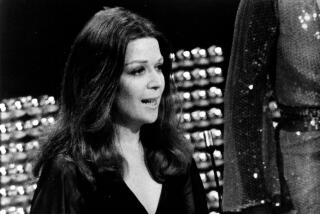âThe Other Sideâ of Buddy Ebsen : Autobiography: The actor--whose career included much more than Jed and Barnaby--will launch his chronicle at a luncheon Jan. 27 at the Balboa Bay Club.
PALOS VERDES ESTATES â Buddy Ebsen had just finished noodling with Fats Wallerâs âAinât Misbehavinâ â on the white baby grand piano in his elegantly appointed living room when he was asked if he still tap-danced.
Ebsen grinned.
âI thought youâd never ask,â he said, blue eyes twinkling and gray loafers gracefully slapping out a time step on the hardwood floor: âYou like that?â
Two months shy of his 86th birthday, Ebsenâs still got it.
More than six decades after a lanky, 6-foot-3 20-year-old from Florida showed up in the Big Apple to break into show biz with only $26.65 in his pocket, the hoofer-turned-actor is getting ready to go back on the road--this time to promote his autobiography.
âThe Other Side of Ozâ (Donovan; $24.95) chronicles his life and career in vaudeville, on Broadway in âWhoopeeâ and the âZiegfeld Follies,â in movies such as âCaptain Januaryâ with Shirley Temple and âBreakfast at Tiffanyâsâ with Audrey Hepburn, and on TV, the medium that gave him superstar status: nine years as folksy Jed Clampett in âThe Beverly Hillbilliesâ and another eight years as the cool and methodical private detective in âBarnaby Jones.â
Thatâs not to mention his role as Fess Parkerâs sidekick Georgie Russell in that baby-boomer cultural phenomenon of the 1950s: âDavy Crockett.â
Ebsen will launch âThe Other Side of Oz,â which is published by Donovan Publishing of Newport Beach, at the Round Table West author luncheon Jan. 27 at the Balboa Bay Club.
The bookâs title refers to Ebsenâs most unusual claim to fame: He was originally cast as the Tin Man in âThe Wizard of Ozâ but, after he nearly died from inhaling the aluminum dust in his makeup, was replaced by Jack Haley.
âI suspect Iâm still in a couple of the long shots because you couldnât tell who was in there and it cost a lot of money to re-shoot,â said Ebsen, adding that heâs sure his voice remains in the âWeâre Off to See the Wizardâ musical number.
As he says in the book: âListen closely next time.â
Dapperly dressed in a burgundy V-neck sweater, open-necked violet shirt and ascot, the actor was seated at a table in the sun room off the kitchen. The Old European-styled two-story house in Palos Verdes Estates, north of Long Beach, has been home since shortly after Ebsen--a former longtime Balboa Island resident--and his wife, Dorothy, were married in 1985.
Ebsen had moved to Balboa Island in 1960, having summered there with his family for a decade. His ex-wife Nancy, whom he divorced a decade ago after 39 years of marriage, served as president of the Newport Harbor Childrenâs Theater Guild and founded the now-defunct Newport Harbor Actors Theater, whose productions included the staging of Ebsenâs play, âMary Queen of Hearts.â
Ebsen himself cropped up periodically in local newspapers, serving as the grand marshal of the Newport Harbor annual Character Boat Parade one year and as honorary chairman for the Providence Speech and Hearing Centerâs fund-raising campaign another year.
But mostly he worked during his Orange County years, commuting daily to Hollywood during the making of âThe Beverly Hillbilliesâ and later, as the county grew and freeway traffic became too heavy, staying in Hollywood during the week while making âBarnaby Jones.â
Like his screen persona, Ebsen is low-key, down-to-earth, gentlemanly. Itâs that down-home quality, grown to avuncular familiarity over the years, that has given him such a long career run.
Most recently, he had a cameo as Barnaby Jones in the âBeverly Hillbilliesâ movie and he just finished filming a guest shot on the new âBurkeâs Lawâ series. A few years ago he performed a one-man show in Branson, Mo., doing, as he says, âwhat I have done all my life: singing, dancing, jokes.â
A history buff and painter who still sails the catamaran he used to win the Trans Pacific race in 1968, Ebsen said heâs been writing down stories and reminiscences for years.
âIâm a scribbler,â he said. âI always wrote down things that I thought were of interest. Also, my mother used to say, âSon, one of these days youâll write a book. So remember all those interesting things that are happening to you.â â
Born in Belleville, Ill., on April 2, 1908, Ebsen is one of five children (he had four sisters). His father worked as a physical culture instructor in a German American athletic and social club and, damming up several springs on their nine acres on the outskirts of town, he created a public swimming pond and resort called the Ebsen Natatorium.
When Ebsen was 12, the family moved to Florida, where his father, who also taught dancing, opened a dance studio in Orlando.
Ebsen originally intended to become a doctor, an ambition fueled by watching one of his sisters suffer seizures from epilepsy. But after two years of premed courses, money ran out and he abandoned medicine in favor of show business.
His father, Ebsen said, had taught all of his children to dance--ballet. âOf course, at that time I resisted it because it was considered a little bit girlish to dance.â Ebsenâs interest in dancing grew in the â20s, however, with the advent of the Charleston, and from that he learned to tap-dance.
Ebsen arrived in New York City in 1928, initially working as a soda jerk to make ends meet. About a year later, he was joined by his sister, Vilma. Billed as Vilma and Buddy Ebsen, they were a hit playing in vaudeville houses and nightclubs.
âI was kind of gawky and tall and it was easy to create eccentric (dance) moves,â Ebsen recalled. âMy sister was the pretty one and I was the funny one, and together we made a good team.â
They were given several screen tests in New York in the mid-â30s, dancing and telling jokes for the camera. Then, as Ebsen says, one screen test âtookâ and they were called out to Hollywood.
A key moment in the book has Ebsen seated across MGM boss Louis B. Mayerâs large polished desk and Mayer, the most powerful man in Hollywood, saying he wanted to sign Ebsen to a seven-year contract.
âMoney is no object,â Mayer said. âBut in order to give you the kind of parts you deserve, Ebsen, we have to own you.â
The word own sent a chill down Ebsenâs spine.
âMr. Mayer,â he replied, âhereâs the kind of fool I am. You canât own me. I canât be a piece of goods on your counter.â
Financial incentives aside, Ebsen recalls, âI just couldnât stand to be owned. It was the way he said it; it came out like capital letters: We have to OWN you.ââ
Looking back, he concedes that âI was young and, by many standards, had a lot to learn.â
And while he occasionally had second thoughts--âon days I was a little lowâ--he never totally regretted turning down the offer. âIt cost something in dollars to me for a while, but in the long run it didnât,â he said.
When World War II broke out, Ebsen recalled, âI was of an age that didnât require I be in the armed services, but I was stubborn and went in anyway.â He served in the U.S. Coast Guard, in anti-submarine duty in the North Pacific.
After the war, he appeared in Oscar Hammersteinâs 1946 revival of âShowboatâ on Broadway. But a year later, he began what he calls in the book âa seven-year economic plague for me.â
From a previous $2,000-a-week motion picture salary to $750-a-week for âShowboat,â he slipped to an average of $135 a week in 1947. A low point for morale came when William Morris Jr.--head of the famous talent agency--suggested that Ebsen, the no-longer-youthful half of a âcute brother and sister team,â retire from show business.
Years later--when âThe Beverly Hillbilliesâ was riding high as the most popular show on television, Ebsen thanked Morris for his earlier âadvice.â
Sums up Ebsen today: âThe big lesson is you get more negative reactions than positive reactions as you go through life, and the big lesson is nobody counts you out but yourself. . . . I never have, I never will.â
After five B Westerns at Republic in the early â50s and occasional TV work, Ebsenâs career logjam was broken when he was hired by Walt Disney to play in âDavy Crockett.â
âNorthwest Passage,â a short-lived TV series, and âBreakfast at Tiffanyâsâ followed.
But the big break came in 1961. He was 53, a time when many actors are looking more at their credits than ahead at their calendars: Ebsen met with TV writer Paul Henning to listen to Henningâs idea for a new TV series.
âThe Beverly Hillbillies,â starring Ebsen as the family patriarch, ran for nine years. Three decades later, itâs still syndicated in more than 30 countries.
âItâs got long legs,â acknowledged Ebsen, uttering Jed Clampettâs most famous catch phrase: âWeeell doggies. Thatâs a piece of Americana. Of course, the whole thing is a piece of Americana.â
As Ebsen sees it, the showâs instant and enduring popularity boils down to one thing:
âIt was a friendly show--friendly and funny in a way that people could understand. Thereâs a term, Iâm not sure the usage of it--other people use it: It related. It related to people. They understood it, and it was funny.â
Ebsen views the story about mountain folks moving to the hills of Beverly as more than just a fish-out-of-water story.
âWhat they did was convert the water to their temperature,â he said with a laugh. âThey didnât ever feel out of water. They thought the others were out of water. They had poise, the Hillbillies. They never felt out of place.â
As Jed, Ebsen essentially played the role of straight man to Granny, Elly May and Jethro, which âwas one of the only things that (initially) bothered me about the show,â he said, recalling that when Henning was describing the proposed series to him âand falling down laughing at all the fun that was going to be in it, I was waiting for him to say when Jed was going to be funny. He wasnât funny.
âThat disturbed me for a bit and so I made a deal: (Iâd do it), provided that Jed always had control of the money. In that way, he could never get lost in the story. So he came out with some good lines, some of them that lived: âSome day, I got to have a long talk with that boy.â â
Ebsen said his character served as the showâs anchor, giving it a âhunk of legitimacy.â Jed, he added, was a âhuman character,â who had âkindness, and a sense of humor and great dignity.â
Not unlike the image Buddy Ebsen has portrayed on television, a personality that seems best-suited to a medium that comes into our living rooms.
âIt could be that I have an intimate personality,â he said. âI did some broad things for the stage, but generally I think I communicated with the close-ups on television. There was some kind of a human kinship, I suppose.â
Viewers, he added with a grin, âknew I meant no harm. I was friendly.â
More to Read
Sign up for our Book Club newsletter
Get the latest news, events and more from the Los Angeles Times Book Club, and help us get L.A. reading and talking.
You may occasionally receive promotional content from the Los Angeles Times.








